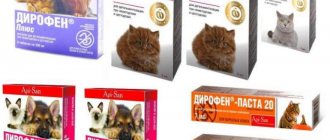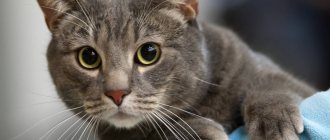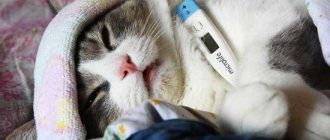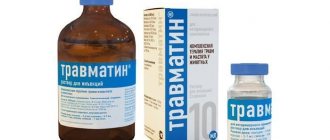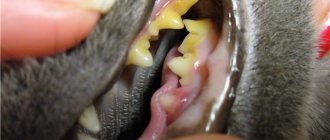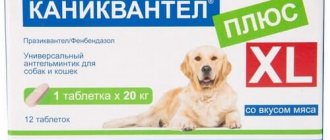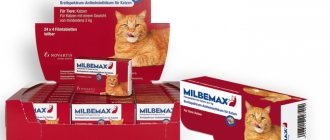- VetConsultPlus
- Informational portal
- Veterinary drug
- Trade name of the drug: Dirofen
- Latin name: Dirophen tabulettae
- Drug group: anthelmintic
- Active ingredients: febantel, pyrantel and praziquantel.
- Dosage form: tablets for oral use.
- Dirofen tablets are produced in three dosages: 120 mg for kittens, 200 mg for cats and small dogs, and 1000 mg each for large dogs.
Compound:
in 1 tablet as active ingredients - febantel - 15 mg, 75 mg, 300 mg; pyrantel - 15 mg, 75 mg, 300 mg; praziquantel - 5 mg, 25 mg, 100 mg and excipients: lactose, calcium stearate, silicon dioxide, talc, cellulose.
Appearance: flat, round, light yellow tablets with two perpendicularly spaced dividing grooves on one side.
The shelf life of the drug, subject to storage conditions, is 3 years from the date of production. Target species: cats and dogs. Do not use Dirofen in cats after the expiration date.
Name and address of the production site of the manufacturer of the medicinal product for veterinary use: LLC NPO "Api-San", Moscow region, Balashikha, Poltevskoe highway, possession 4.
General information
According to the instructions, 1 tablet of Dirofen (120 mg, 200 mg and 1000 mg) contains the following active ingredients:
- febantel - 15 mg, 75 mg, 300 mg, respectively
- pyrantel - 15 mg, 75 mg, 300 mg, respectively
- praziquantel - 5 mg, 25 mg, 100 mg, respectively
- excipients: lactose, calcium stearate, silicon dioxide, talc, cellulose
Dirofen for cats is produced packaged in 6 tablets in strips made of laminated paper or in jars made of polymer material with lids with first-opening control and packaged individually in cardboard boxes complete with instructions for use.
Store Dirofen tablets for kittens and cats in the manufacturer's sealed packaging, in a place protected from direct sunlight, separately from food and feed at a temperature of 0 °C to 25 °C.
Dirofen should be stored out of the reach of children. According to the instructions for use, unused drug is disposed of in accordance with legal requirements. Conditions of release: without a veterinarian's prescription.
Pharmacological properties of Dirofen
Dirofen for cats is classified as a combination anthelmintic drug.
The combination of praziquantel, febantel and pyrantel, which are part of Dirofen, provides a wide spectrum of its anthelmintic effect on all phases of the development of round and tapeworms parasitizing the gastrointestinal tract of cats:
- Alveococcus multilocularis
- Ancylostoma caninum
- Diphyllobothrium latum
- Dipylidium caninum
- Echinococcus granulosus
- Mesocestoides lineatus
- Multiceps multiceps
- Toxascaris leonina
- Trichuris vulpis
- Uncinaria stenocephala
- Tohosara mystax
- Tohosara canis
Praziquantel is the second active ingredient of Dirofen
Praziquantel is a compound of the pyrazinisoquinoline group, active against gastrointestinal cestodes at all phases of development. By increasing the permeability of the parasite's cell membranes to calcium ions, it causes depolarization of the membranes, muscle contraction and destruction of the tegument, which leads to the death of helminths and promotes their elimination from the cat's body. The compound is rapidly absorbed in the gastrointestinal tract, reaching a maximum concentration in the blood plasma after 1-3 hours, reversibly binds to serum proteins (70-80%), is partially metabolized in the liver in cats, is re-excreted into the intestines, and is mainly excreted from the body with urine (up to 80%) within 24 hours.
Febantel is the third active ingredient of Dirofen
According to the instructions, febantel belongs to probenzimidazoles, which are biotransformed in the body into benzimidazoles. The mechanism of action of febantel is based on inhibition of the fumarate reductase enzyme in the mitochondria of helminths, as a result of which the absorption of glucose and the synthesis of the protein tubulin are disrupted, which leads to the destruction of the microtubular apparatus of the parasite cells, causing its death. Febantel is absorbed in the intestine, metabolized in the liver and excreted with bile into the intestinal lumen, where its repeated resorption is partially noted; it is excreted from the body of cats both in unchanged form and in the form of several metabolites in feces and urine.
According to GOST 12.1.007-76, dirofen for domestic cats, in terms of the degree of impact on the cat’s body, is classified as a low-hazard substance (hazard class 4), in recommended doses it does not have embryotoxic, teratogenic or sensitizing effects. The drug is well tolerated by dogs and cats of different breeds and ages.
Analogs
Miramistin has analogues. It can be replaced by drugs with similar effects and indications:
- Chlorhexidine;
- Mestamidine;
- Hexoral;
- Tantum Verde;
- Furacilin.
Chlorhexidine
Antiseptic with a wide spectrum of action. Its active ingredient is chlorhexidine bigluconate. The drug causes an antiseptic and bactericidal effect. It is used in various fields of medicine for the prevention and treatment of infectious diseases. Indications for the use of Chlorhexidine:
- pharyngitis;
- tonsillitis;
- angina;
- stomatitis;
- periodontitis;
- disinfection of removable dentures;
- rhinitis;
- laryngitis;
- burns of varying severity;
- colpitis;
- cervical erosion;
- risk of contracting sexually transmitted infections.
Chlorhexidine is not used during pregnancy or to treat children.
Mestamidin
Antiseptic with a wide spectrum of action. Its active components are glycol ether and octenidine. The medicine helps heal wounds and prevents the growth of pathogens. It is made in the form of a solution in vials with a spray bottle. This topical agent is indicated in the following cases:
- stomatitis;
- mycosis of the skin;
- herpes; pharyngitis;
- laryngitis;
- tonsillitis;
- burns;
- skin treatment before surgery.
The medicine can be used during pregnancy and breastfeeding. It is also prescribed to young children. The solution is used to disinfect medical instruments. The drug is made in the form of a spray. It is not suitable for insertion into the urethra and vagina. If the medicine gets into your eyes, you should immediately rinse them thoroughly with running water.
Hexoral
Antimicrobial agent. Active ingredient: hexethidine. The medicine effectively treats infections caused by gram-positive and fungal microorganisms. It is made in the form of suckable tablets, solution, spray. Used for:
- gingivitis;
- periodontal disease;
- stomatitis;
- sore throat;
- mycoses of the oral mucosa;
- to prevent infections after surgery.
During pregnancy and breastfeeding, the medicine is used only under the supervision of a physician.
Dosing of Dirofen for cats
Tablets for kittens - 1 tablet per 1 kg of animal weight;
Tablets for cats and dogs of small breeds - 1 tablet per 5 kg of animal weight
According to the instructions, in case of an overdose of Dirofen in cats
a depressed state, refusal to feed, excessive salivation, and gastrointestinal upset may occur. In these cases, general measures are used aimed at removing the drug from the body.
When using the drug for the first time in cats, self-limiting hypersalivation is possible.
For pregnant cats, Dirofen tablets are prescribed 3 weeks before the expected birth with caution, under the supervision of a veterinarian, for lactating females - 2-3 weeks after birth.
Violations of the deworming regimen for animals should be avoided, as this may lead to a decrease in effectiveness. If the next deworming is missed, the drug must be administered as soon as possible in the same dose, then the interval between administrations of the drug does not change.
When using Dirofen tablets in accordance with these instructions, side effects and complications in animals, as a rule, are not observed. Some animals may experience disturbances in the gastrointestinal tract (loose stools, vomiting) and increased salivation, which disappear spontaneously and do not require the use of medications.
Dirofen tablets should not be used concomitantly with piperazine and cholinesterase inhibitors.
According to the instructions for use in veterinary medicine, Dirofen tablets are not intended for use in productive animals.
Indications for use
Dirofen is used to prevent helminthic infections in cats and treat them. Helminth infections pose a serious danger to the animal, causing severe infestation, which without urgent treatment can lead to death.
Indications for the use of tablets are as follows:
- lesions by roundworms;
- lesions by tapeworms;
- complex infection with flat and round worms;
- prevention of helminthiasis.
Important! Kittens should not be given medicine intended for adult cats.
Veterinarians strongly recommend using the composition regularly to prevent the appearance of worms. Parasites are dangerous not only for animals, but also for humans, as they are quickly transmitted from cats to people through constant contact with the animal.
Be sure to read:
Nonestrone for cats: instructions for use, indications, dosage and duration of use
Personal prevention measures
When working with Dirofen, you should follow the general rules of personal hygiene and safety precautions provided for when working with medications.
Smoking, drinking and eating are prohibited during work. When finished, wash your hands with warm water and soap. It is prohibited to use empty packaging of the drug for household purposes; it must be disposed of with household waste.
According to the instructions, in case of accidental contact of the drug with the skin or mucous membranes of the eyes, they must be rinsed with plenty of water. People with hypersensitivity to the components of the drug should avoid direct contact with Dirofen. If allergic reactions occur or if the drug accidentally enters the human body, you should immediately contact a medical facility (bring with you the instructions for use of the drug or the label).
Name, address of the organization authorized by the holder or owner of the registration certificate for the medicinal product Dirofen for cats and kittens to accept claims from the consumer: LLC NPO "Api-San", Moscow region, Balashikha, Poltevskoe highway, possession 4.
Advantages and disadvantages
The advantages of Dirofen include the following factors:
- convenient release forms (many drugs are available only in tablet form);
- convenient dosage (you can choose a modification that suits a specific cat);
- the tablet can be easily divided into 4 parts due to the risks;
- Possibility of use for pregnant, lactating cats and kittens;
- high degree of efficiency;
- reasonable price (suspension and paste 7 ml - from 150 rubles, tablets - from 25 rubles per piece).
But Dirofen also has disadvantages:
- there are contraindications;
- the anthelmintic does not have a pleasant taste (like some other drugs);
- not all pharmacies have the required form of the drug;
- there is a possibility of a side effect - increased salivation.
One of the advantages of the drug is that some pharmacies sell Dirofen tablets individually
Learn about essential antimicrobials in animals
- Trichopolum instructions for veterinary medicine
- Instructions for the use of the antibiotic Baytril in animals
- Instructions for use of metronide
- Instructions for ceftriaxone preparations for animals
- Use of Metrogyl in veterinary medicine
- Instructions for doxycycline in animals
- Metronidazole (Metronidazole) for animals (instructions for use in veterinary medicine, doses, indications and contraindications)
- Atovaquone (ATOVAQUONE)
- Azithromycin, instructions for animal therapy
^Top
Side effects
In case of overdose and intolerance of the drug to a specific animal, the following symptoms may occur:
- increased salivation;
- loss of appetite;
- vomit;
- diarrhea;
- allergic reactions;
- lethargy of the pet.
In case of side effects, it is recommended to give the animal an adsorbent drug: activated carbon or smecta.
In case of side effects, it is recommended to give the animal an adsorbent drug
